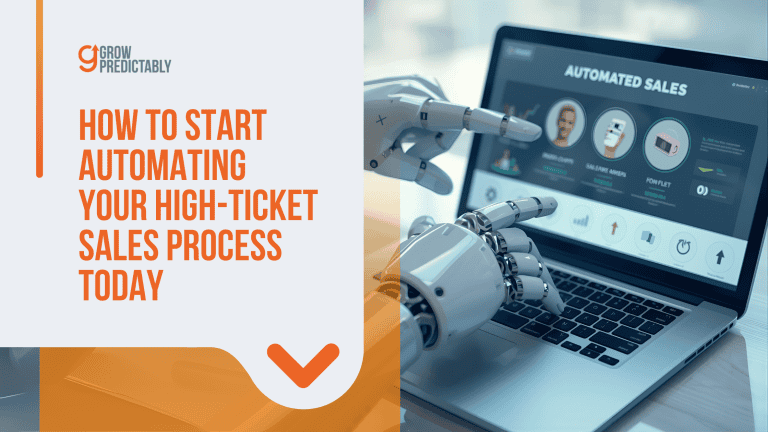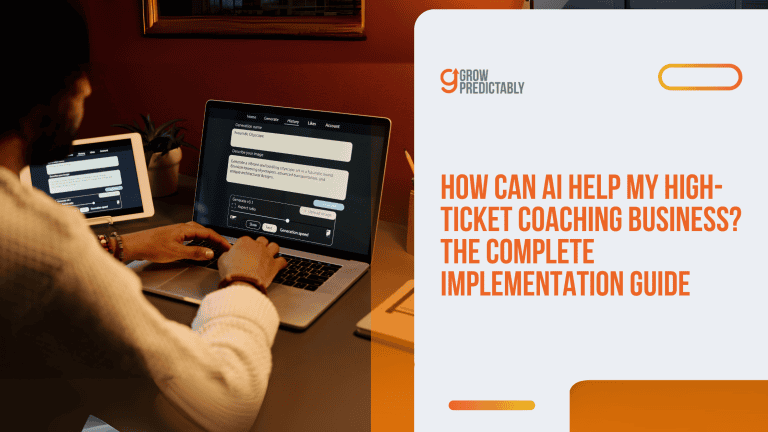How to Reduce Coaching Client Churn with Automation? – 7 Proven Ways That Work
Reducing coaching client churn can feel like a constant battle, especially if it’s draining time and limiting growth goals.
If you’re wondering how to reduce coaching client churn with automation, the answer centers on streamlining onboarding, personalizing client engagement, and automating key relationship touchpoints using proven strategies.
By implementing automation into your coaching business, you address common retention bottlenecks, slash administration time by up to 80%, and can manage twice as many clients without sacrificing service quality.
Everything you need to confidently reduce churn and drive sustainable growth is in this guide.
Let’s turn these insights into your new reality!
TL;DR
Reducing client churn in high-ticket coaching requires integrating automation at key touchpoints, from onboarding to follow-ups. By automating communication, scheduling, and milestones, coaches can enhance client satisfaction, prevent drop-offs, and elevate engagement, ultimately securing recurring business and improving customer lifetime value.
KEY TAKEAWAYS
- Implement automated onboarding workflows to ensure a smooth start for new clients, enhancing their initial experience and reducing early drop-offs.
- Use automated check-ins and progress surveys to keep clients engaged and aware of their progress, preventing motivation dips that lead to churn.
- Develop nurturing sequences tailored to at-risk clients to re-engage them with personalized messages and highlight their past successes.
What’s The Role of Automation in Fighting Churn in High-Ticket Coaching?
If you’re losing just 2 clients a month, you may be bleeding $20K in unclaimed revenue — and few coaches realize it until it’s too late.
Client churn in a high-ticket coaching business is like a leaky bucket: even a trickle of drop-offs can quietly erode your entire growth potential.
What’s happening behind the scenes?
Each time a client walks away, they reduce the customer lifetime value by taking with them not just their immediate payment, but all future revenue, referrals, and testimonials that would have fueled your business growth.
This silent drain creates a ceiling that keeps your coaching practice stuck and, consequently, affects customer satisfaction and customer loyalty, no matter how hard you hustle to find new clients.
What is The Hidden Cost of Managing Your Clients Manually?
While you’re busy juggling client communication, session reminders, and progress tracking by hand, these manual processes are stealing your most valuable asset – time.
For instance, picture this: It’s 9 PM on a Thursday, and focusing on customer success feels like a distant priority.
You’ve just finished your last coaching call, but instead of resting or planning your business growth, you’re sending follow-up emails, manually updating client progress sheets, and trying to remember who needs a check-in tomorrow.
This admin drag isn’t just exhausting – it’s actively preventing you from scaling.
The truth? This can quickly become counterproductive to customer success.
In one Entrepreneur article on ‘How Inefficient Processes Are Hurting Your Company’ numbers show that companies lose 20-30% in annual revenue due to manual and inefficient processes. (Source)
In fact, manual client management can create the perfect storm for churn:
- Inconsistent communication leaves clients feeling forgotten
- Critical onboarding moments get missed in the shuffle negatively affecting customer success
- Touchpoints fall through the cracks when you’re busy with delivery
How Does Automation Break the Income Ceiling?
Automation isn’t about removing the human touch; rather, it’s about freeing you to be more human where it counts.
Think of automation as your always-on assistant that ensures no client slips through the cracks, effectively minimizing customer churn.
Imagine having systems that automatically:
- Send personalized progress updates that feel like they came directly from you
- Deliver timely session reminders without you lifting a finger
- Trigger congratulatory messages when clients hit milestones
- Check in with clients who haven’t engaged recently
These touchpoints preserve the premium, high-touch feel of your offer while running in the background – enhancing customer satisfaction and giving you back hours every week to focus on what you do best: transforming lives through coaching.
How Can The Customer Journey Guide Your Automation Plan?
To implement automation effectively, we need a framework that maps the client experience from start to finish.
It’s a framework that’s designed to bring value to your clients at every stage, thereby boosting efforts to reduce customer churn.
This is where the Customer Value Journey (CVJ) comes in – a proven roadmap that enhances the overall customer experience, guiding clients from first becoming aware of your coaching to eventually becoming promoters of your business.
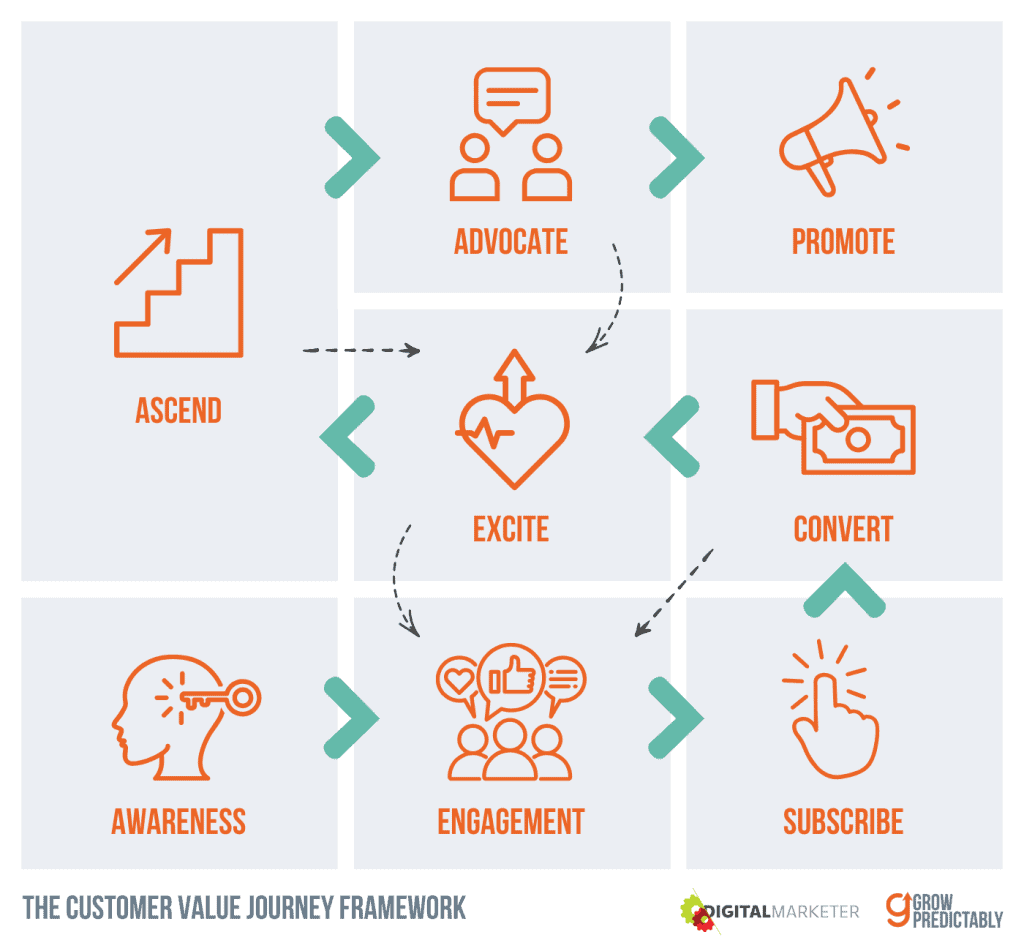
Imagine having a framework that automatically map out every stage of the customer journey:
- Awareness: When prospects first discover you
- Engagement: When they begin interacting with your content
- Convert: When they become paying clients
- Excite: When they experience initial wins
- Ascend: When they purchase additional offerings
- Promote: When they refer others to you
By mapping automation to these specific journey stages, you can create a seamless customer experience that naturally works to reduce customer churn throughout the client’s journey.
It’s also worth noting that almost 90% of CX professionals leveraging customer journey mapping report improved performance in customer experience KPIs such as:
- Higher Customer Satisfaction
- Lower Customer Churn
- Improved Net Promoter Score (NPS)
This is according to an InMoment resource on customer journey mapping strategies for improving business performance. (Source)
Three Core Benefits of Automation for High-Ticket Coaches
- Time Savings: Automation slashes admin hours by 70-80%, freeing you to focus on delivery and growth instead of drowning in follow-ups and reminders.
- Improved Retention: Consistent touchpoints build deeper relationships. When clients receive regular check-ins, milestone celebrations, and progress reminders, they stay engaged and connected to their goals – making them far less likely to drop off.
- Scalability: With workflows running in the background, you can serve more existing customers without decreasing quality, all while maintaining a low customer churn rate. Your systems maintain the high-touch experience while you focus on delivering transformation.
Why this reduces churn: Automation ensures no client is forgotten — the experience feels consistent, high-touch, and proactive, increasing the likelihood they stay and refer.
In summary, automation helps high-ticket coaches reclaim their time, retain more clients, and scale their practice sustainably.
The key is implementing the right systems at the right stages of the Customer Value Journey.
In the next section, I’ll share 7 specific automation tactics that map directly to this journey – giving you practical ways to plug the leaks in your coaching business and transform client retention.
What Are 7 Ways Coaches Can Use Automation to Fight Client Churn?
Remember that leaky bucket we talked about?
Now let’s plug those holes!
Let’s map these seven automation tactics directly to the Customer Value Journey framework, showing exactly how each one reduces the customer churn rate and stops clients from slipping away.
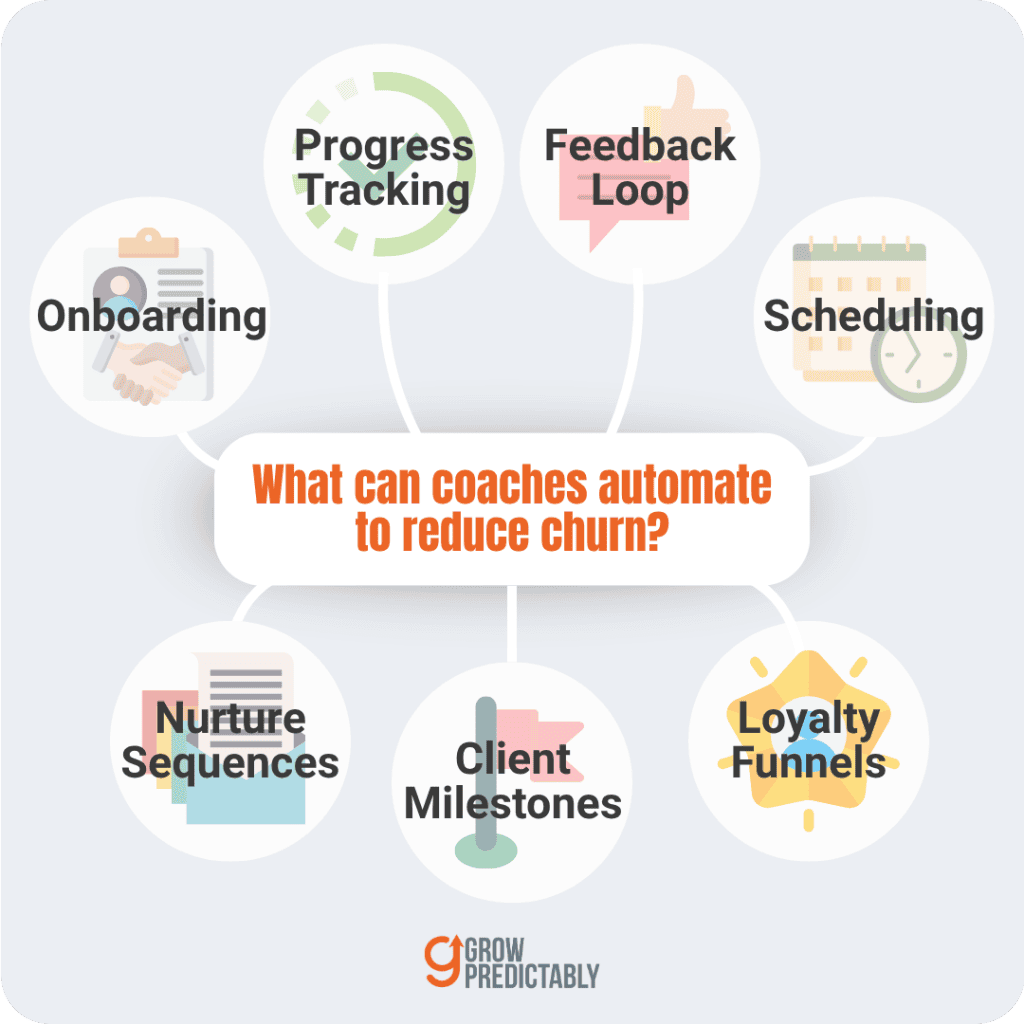
1. Automated Onboarding Workflows (Awareness & Engagement)
The first 14 days has a significant impact on customer retention; this timeframe determines whether clients stay for long or not.
When clients feel lost or confused at the start, they’re already mentally checking out.
Picture this: Your new client signs their contract and then… silence, a missed opportunity that can contribute to customer churn.
Or worse, they’re bombarded with confusing emails asking them to fill out forms with no context.
That’s how relationships start to crack before they even form.
An automated onboarding sequence delivers the right information at exactly the right time.
This includes:
- Welcome videos that build excitement
- Bite-sized pre-work that creates quick wins
- Clear expectations about what happens next
- Resource access instructions without overwhelm
One coach I worked with saw a 32% increase in program completion after implementing a structured 7-day onboarding sequence that gradually introduced resources instead of dumping everything at once.
CVJ Connection:
This bridges the critical gap between Awareness and Engagement, enhancing the customer experience and ensuring clients feel confident they made the right choice.
2. Check-Ins & Progress Tracking (Excite)
Clients who can see their progress stay motivated.
Those who can’t often disappear.
Most clients hit motivation dips around weeks 3-5 of a program.
Without intervention, these dips become permanent exits.
Automated check-ins create touchpoints that catch wavering commitment before it becomes churn.
Set up systems that:
- Send quick pulse surveys after key milestones
- Deliver automated “How’s it going?” check-ins between sessions
- Provide progress visualization tools that show how far they’ve come
When clients receive a simple “What’s one win you’ve had since our last call?” prompt mid-week, they’re reminded to notice their progress, boosting positive customer sentiment, rather than focusing on what’s still hard.
CVJ Connection:
These check-ins create those crucial “Excite” moments that reinforce the client’s decision to work with you.
3. Feedback Loops & Surveys (Advocate)
Clients who feel heard stay longer than those who silently struggle.
Many coaches are shocked to discover clients left because of easily fixable issues they never mentioned — instances within the customer journey that, when addressed promptly, could’ve helped reduce customer churn.
Automated feedback loops create safe spaces for customer feedback and gauge customer sentiment, allowing clients to voice concerns before they become deal-breakers.
Implement:
- Mid-program satisfaction checks
- Anonymous feedback options
- “Temperature check” emoji responses (super quick to answer)
- Action-triggered surveys after key milestones
One business coach reduced her churn by 18% simply by adding a one-question survey after the fourth session: “Is there anything we haven’t covered that you were hoping to address?”
CVJ Connection:
This builds the foundation for the Advocate stage by showing clients you genuinely care about the customer experience.
4. Automated Scheduling & Reminders (Convert)
Missed sessions often lead to program abandonment.
Moreover, clients who consistently show up get better results.
The friction of scheduling is a silent killer of coaching relationships.
When clients have to email back and forth to find time or regularly miss sessions because they forgot, the relationship deteriorates fast, affecting customer retention.
Your automated scheduling system should:
- Send session reminders 24 hours and 1 hour before calls
- Include prep questions to make sessions more productive
- Offer easy rescheduling options
- Follow up with session recordings or notes
In one NCBI case study about the usage of automated self-scheduling in a community-based physician group, results show an uptake of self-scheduling increased from 4% to 15% of kept appointments. (Source)
CVJ Connection:
This streamlines the Convert stage and creates consistency that builds trust throughout the journey.
5. Nurture Sequences for At-Risk Clients (Ascend & Promote)
Re-engaging wavering clients is easier than replacing them.
Every coach knows the signs: a client misses a session, stops completing assignments, or goes quiet on communication channels.
These are your red flags, a sounding alarm to reduce customer churn.
Create automation triggers for:
- Missed session follow-ups with caring check-ins
- Re-engagement emails for clients who haven’t logged into your portal
- Value-reminder sequences highlighting past wins
- “We miss you” campaigns with success stories from other clients
A life coach I worked with implemented an automated 3-email sequence triggered when existing customers missed assignments two weeks in a row.
It brought 23% of wavering clients back into full engagement.
CVJ Connection:
These nurture sequences help clients Ascend to deeper commitment and prevent customer churn rather than dropping off.
6. Client Milestones & Referral Nudges (Promote)
Celebration creates emotional connection and reminds clients of their progress.
Clients often don’t realize how far they’ve come without someone pointing it out.
Automated milestone celebrations create moments of pride for existing customers that strengthen the coaching relationship, foster customer loyalty, increase customer lifetime value, and bolster customer retention.
Create automations that:
- Celebrate completion of modules or time milestones
- Highlight specific achievements based on tracking
- Send small digital “gifts” at key points (resources, templates)
- Introduce natural referral opportunities when clients are most excited
The simple act of sending an automated “Congratulations on completing your first month!” email with a summary of work done can spike re-enrollment rates by 15-20% and boost customer loyalty.
CVJ Connection:
These celebratory moments create natural openings for the Promote stage, turning happy clients into referral sources.
7. Post-Completion Loyalty Funnels (Ascend)
The end of one program should be the beginning of an ongoing relationship.
Many coaches make the mistake of letting relationships fizzle after a program ends.
Automated post-program sequences maintain the connection and create natural pathways to continued work.
Your post-completion funnel should include:
- Results recap celebrations
- “What’s next?” strategy sessions
- Alumni community invitations
- Next-level offering introductions
- Periodic check-ins even months later
One business coach increased her re-enrollment rate by 34% by adding a 30-day post-program sequence that included testimonial requests, wins celebration, and a strategy session invitation.
CVJ Connection:
This creates a seamless transition from one Ascend opportunity to the next, helping to reduce customer churn and keeping clients in your ecosystem.
Start Small, Win Big
You don’t have to implement these tactics all at once to fight churn with smart automation.
Start with one that addresses your biggest churn point.
Master it. Then add another. You don’t have to do it everywhere all at once.
Automation is good, so long as you know exactly where to put the machine.
Eliyahu Goldratt, Business Management Guru
Each automation you add lifts retention and brings more freedom to focus on what you do best: coaching transformation and creating customer success.
The beauty of these systems is that they don’t replace your personal touch—they enhance it by ensuring no client falls through the cracks while you’re busy delivering exceptional coaching.
Bonus Automation Hack: A 15-Minute Churn Reduction Win
Do you have 15 minutes to spare?
That’s all you need to plug one of the biggest leaks in your coaching business—missed calls that turn into lost clients.
For example, you’ve qualified a potential client.
They’ve booked a discovery call, and you’re ready to wow them with your expertise… but they don’t show up.
And just like that, a potential $5,000-$10,000 relationship slips away because you’re too busy with current clients to follow up quickly.
This happens more than we’d like to admit.
But, it’s completely preventable with one simple automation.
The No-Show Rescue System
Here’s your 15-minute fix that can save thousands in potential revenue:
First, connect Calendly (or your scheduling tool) with Zapier.
Next, create a trigger that activates when someone misses their appointment.
Then, set up an automatic email sequence that:
- Expresses concern (“Hey, I noticed we missed our call today”)
- Offers a quick reschedule link
- Includes a personal touch (“I was looking forward to discussing your goals around [their specific challenge]”)
The magic happens when this system works while you’re busy serving other clients or creating content.
No manual tracking needed!
How to Set It Up (Even If You’re Not Tech-Savvy)
Here are the steps:
- Step 1: In Zapier, choose Calendly as your trigger app
- Step 2: Select “No Show” as your trigger event
- Step 3: Connect your email provider (Gmail, Outlook, etc.)
- Step 4: Create a template with personalization tokens like {{first_name}} and {{appointment_type}}
- Step 5: Set a follow-up sequence: immediate email, then 24-hour check-in if no response
Here’s a success story for you.
One coach I worked with recovered 6 missed calls in a single month using this system.
That’s $30,000 in potential business saved with 15 minutes of setup time!
This automation wins because it hits at a critical moment when leads are most likely to disappear.
The quick, personal follow-up creates a “wow” experience that actually strengthens the relationship.
They feel remembered and valued even after missing the appointment.
Plus, it removes the awkwardness of having to chase them down.
Your system does the reaching out, which feels less pushy than you sending manual follow-ups.
What Are 5 Common Mistakes to Avoid When Automating Your Coaching Business?
Did you know that over-automation causes a 20% drop in client retention?
That’s right!
While automation can save your coaching business, it can also sink it if done carelessly.
Automation is like a powerful kitchen knife—incredibly useful in skilled hands but potentially dangerous if mishandled.
Let’s look at the five most common mistakes coaches make when automating their client experience and how you can sidestep them.
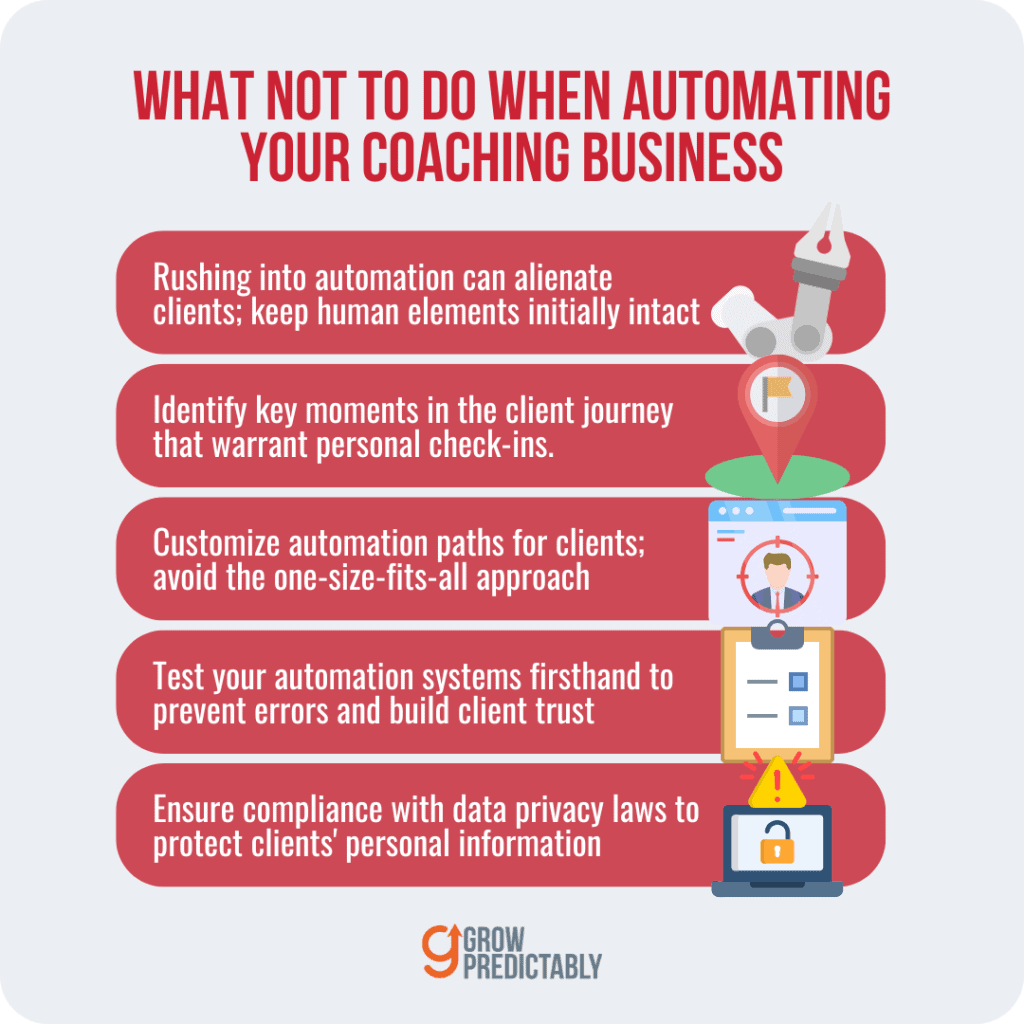
1. Going Too Robotic, Too Fast
Many coaches get excited about automation and replace every human touchpoint overnight.
Big mistake!
Your clients chose you for your expertise and personality—not to interact with a robot.
When you remove all human elements, clients feel the difference immediately.
Quick Fix:
Start by automating just your backend processes first.
Keep client-facing communications mostly personal, then gradually introduce automation where it enhances rather than replaces your presence.
2. Forgetting the Personal Check-In Points
I’ve seen coaches set up beautiful automated systems but completely miss critical personal touchpoints at key moments in the client journey.
Indeed, your clients hit emotional highs and lows during their transformation.
An automated message when they’re struggling can feel tone-deaf and disconnecting.
In fact, according to a Forbes resource, 71% of consumers feel frustrated when a shopping experience is impersonal and 72% of consumers reveal they only engage with personalized messaging. (Source)
Quick Fix:
Map your client journey and identify emotional pivot points—moments of doubt, breakthrough, or decision.
These deserve your direct attention, even if just a quick voice note or personal text.
3. Creating a “One-Size-Fits-All” Experience
Not every client moves at the same pace or needs the same support.
Yet many coaches create rigid automation sequences that force everyone through identical experiences.
When a high-achiever client feels held back by your automation, or a client who needs more support feels rushed, they’ll look elsewhere for coaching that fits their pace.
Quick Fix:
Therefore, build branch points into your automations based on client behavior, progress, or direct feedback.
Use conditional logic in your email platform or client portal to create multiple paths based on customer behavior.
4. Neglecting to Test Your Systems
Nothing erodes trust faster than broken automations.
Imagine a client receiving the wrong name in an email, duplicate messages, or worst of all—nothing when they were promised support.
Many coaches set up systems but never experience them from the client side, missing glaring issues that scream “I don’t really care about you.”
Quick Fix:
Create a test account and go through your entire client experience yourself.
Better yet, ask a friend or team member to do it and give honest feedback about how it feels.
5. Ignoring Data Privacy and Security
With increasing privacy regulations worldwide, coaches who casually collect and store client data without proper systems risk serious legal consequences—not to mention client trust.
Your clients share deeply personal information with you.
When automation tools handle this data carelessly, you’re breaking both legal and ethical obligations.
Quick Fix:
Audit your tools for GDPR and other privacy compliance.
Create clear data policies, secure your systems with strong passwords and two-factor authentication, and be transparent with clients about how their information is stored and used.
How to Balance Automation with Authenticity?
The most successful coaches use automation to enhance the customer experience and client relationships, not replace them.
Think of automation as your assistant, not your substitute.
When done right, automation creates space for deeper, more meaningful coaching moments.
It handles the routine so you can focus on transformation.
Remember: The goal isn’t to automate everything—it’s to automate the right things in the right way, preserving your unique coaching magic while scaling your impact.
The Human-AI Partnership
The magic happens not when AI replaces coaches, but when it amplifies their uniquely human gifts.
The most successful coaches will leverage automation to:
- Expand Listening Capacity: AI helps you “hear” clients across multiple channels simultaneously
- Enhance Intuition: Providing pattern recognition that complements your coaching instincts
- Create Space for Depth: Handling routine interactions so you can focus on transformative moments
Think of AI as your coaching co-pilot—handling the navigation while you focus on the destination and the meaningful conversations along the way.
Finding the Balance: Tech and Soul
Despite these exciting advances, a word of caution: clients still crave authentic human connection.
The coaches who win won’t be those with the most automation, but those who use technology to create more meaningful human moments.
The sweet spot lies in using AI for what I call “invisible automation”—technology that clients never see but that enables you to show up more fully when it matters most.
Like the stage crew in a Broadway show, good automation creates magic without stealing the spotlight.
As we move forward, the most successful coaches will be those who embrace technology not as a replacement for connection, but as a tool that creates more space for it, ultimately enhancing customer loyalty.
Your clients don’t want a robot coach—they want a human guide focused on customer success, using every available tool to help them succeed.
In the end, coaching automation isn’t about replacing you—it’s about multiplying you.
It’s about creating an experience where clients feel your presence, wisdom and support even when you’re not physically there, ultimately boosting customer lifetime value.
Because in a world of increasing digital noise, personalized human connection becomes not just valuable, but essential.
Action Plan for Success Managers: Reduce Client Churn with Automation Today
Let’s face it—you’ve just read through all these amazing automation strategies.
But will you actually implement them?
The harsh truth is that 80% of coaches who learn about automation never take the first step.
They get overwhelmed, put it off until “next week,” and continue losing clients while manually sending those same follow-up emails at 11 PM.
Don’t be that coach!
Your clients deserve better, and frankly, so do you.
Let’s break this down into a simple 5-step plan you can start today—even if technology makes you nervous.
| Step | Description | Action |
|---|---|---|
| Step 1: Audit Your Client Touchpoints (Awareness & Engagement) | Map interactions from discovery call to final session. Identify disengagement patterns. | Draw your client journey, circle where clients “go quiet” or seem less excited. These are automation opportunities. |
| Step 2: Choose ONE Automation to Implement First (Convert) | Focus on the most impactful touchpoint first, like onboarding or session reminders. | Set up a missed-call follow-up; takes just 15 minutes for a quick win. |
| Step 3: Select Your Tool and Set Up Your First Workflow (Excite) | Choose a tool like Calendly + Zapier or a platform like Coachvox. Perfect one automation first. | Block 60 minutes this week titled “Set Up My First Automation” to focus on this task. |
| Step 4: Test and Refine Your Message (Ascend) | Ensure your automated messages have warmth and sound like you. | Write a personal template for automation, include the client’s name and journey specifics. |
| Step 5: Measure Impact and Build Your Next Automation (Promote) | Track metrics over 30 days to see improvements in attendance or homework completion. | Create a spreadsheet to compare metrics “before automation” and “after automation.” Even simple data shows progress. |
Remember: Progress Beats Perfection
You don’t need to become a tech wizard overnight.
Even implementing one automation can reclaim hours of your time and significantly improve client retention.
One of my clients began with just an automated check-in message between sessions to strategically boost customer retention.
This single automation reduced her churn by 22% in the first month—because clients felt consistently supported rather than forgotten between calls.
FAQs
The Empowerment Path
As we’ve explored, client churn can quietly undermine your high-ticket coaching business, but automation offers a powerful solution.
By mapping systems to the Customer Value Journey (CVJ), you preserve your unique touch, save time, boost retention, and finally break through your income ceiling.
Imagine a practice where clients feel guided and supported at every step, while you reclaim your evenings and scale with confidence.
Now is your chance to take control—don’t let another hard-won client slip away due to preventable missteps.
What’s holding you back from implementing your first automation today? Share your biggest obstacle in the comments below, and let’s tackle it together.
The future belongs to coaches who blend technology with authentic connection.
By acting now, you set the standard for premium client experiences in an increasingly competitive industry.
Don’t just automate—elevate your impact!




